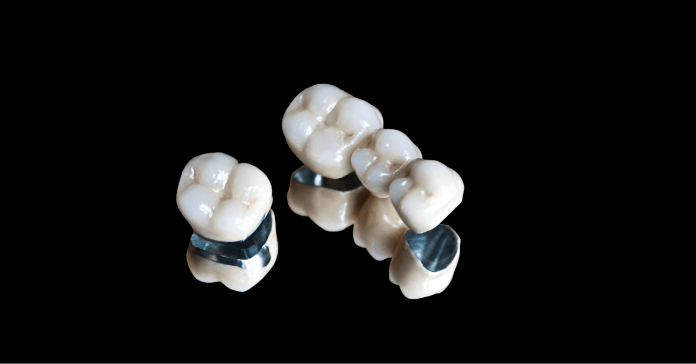If you need a dental crown but are unsure what type to choose, you may want to consider a porcelain fused-to-metal crown. It is the most common type of crown used in dentistry today due to its durability, aesthetic qualities, and cost-effectiveness. In this blog post, we’ll discuss the benefits and drawbacks of porcelain fused to metal crowns (PFM) and maintenance tips to keep them looking great for years.
What is a Porcelain Fused to a Metal Crown?
A porcelain fused to metal crown (PFM) is a dental restoration that combines the strength of metal with the aesthetic appeal of porcelain. It consists of two layers – a metal base and an outer layer of porcelain.
The metal layer provides strength and durability, while the porcelain outer layer gives it a natural-looking appearance that blends in with your surrounding teeth.
Porcelain fused to metal crowns are commonly used to restore the shape and function of damaged or decayed teeth. Also, they are recommended after root canal treatment to protect the tooth from further damage and for bridges to replace missing teeth.
Benefits of a Porcelain Fused to Metal Crown
- Strength and durability: Both layers of the porcelain fused to metal crown (PFM) are very strong and durable, making them a good choice for back teeth (molars and premolars) that receive a lot of chewing force.
- Aesthetically pleasing: The outer layer of porcelain gives the crown a natural-looking appearance that blends in with your surrounding teeth. This makes them a good choice for front teeth (incisors and canines), where aesthetics is important.
- Cost-effective: PFM crowns are usually less expensive than all-ceramic crowns, making them a more budget-friendly option for many patients.

Drawbacks of a Porcelain Fused to Metal Crown
There are also some drawbacks to consider when it comes to a porcelain fused to metal crown.
- Dark lines: PFM crowns are not as aesthetically pleasing as all-porcelain crowns because the metal layer is sometimes visible at the edges, especially when gums recede, causing a dark line around the crown.
- Abrasion of the opposing natural teeth: Porcelain may wear down the opposing natural teeth during normal chewing because it is harder than natural teeth enamel.
- Chipping of porcelain: Porcelain can chip off over time due to wear and tear, revealing the metal layer underneath. Your dentist may repair or replace a chipped crown with exposed metal.
- Metal Allergies: In some cases, patients may develop an allergic reaction to the metal in a PFM crown.
Alternatives
Full metal crowns provide a strong and durable solution, but they lack the aesthetic appeal of PFM crowns since they have an obvious metallic appearance. A metal crown is less expensive than a PFM crown and doesn’t cause abrasion of the opposing natural teeth.
All ceramic crowns provide a more natural appearance than PFM crowns since they don’t have a metal layer underneath. They also do not cause an allergic reaction in patients with metal allergies. However, they are usually more expensive than PFM crowns.
Discuss all your options with your dentist so you can make an informed decision about which type of crown is best for your needs and budget.
How to Care for Your Porcelain Fused to Metal Crown?
Although porcelain fused metal crowns are strong and durable, they require proper care and maintenance to ensure they last. Here are some tips on how to care for your porcelain fused metal crown:
- Brush your teeth at least twice a day with fluoride toothpaste. Make sure you brush carefully around the crown and between your teeth to remove plaque and food particles.
- Floss daily to clean in between your teeth and under the gum line.
- Visit your dentist for regular checkups and professional teeth cleaning at least twice a year so they can catch any problems early on.
- Avoid chewing on hard objects such as pencils, ice cubes, or fingernails, which can chip or damage your crown.
- Don’t use your teeth as tools to open packages or remove staples.
- Don’t use abrasive toothpaste to clean your crown, as this may cause scratches or discoloration over time.
- Quit smoking or using any tobacco products because they can cause gum disease and receding gums, making the metal layer of the crown visible.
- Wear a mouthguard when playing contact sports to protect your teeth from damage.
Following these tips can help you ensure that your porcelain fused metal crown lasts longer and maintains its aesthetic appeal.
Conclusion
Porcelain fused metal crowns are a strong and durable restoration that can protect your tooth and restore its natural appearance. They consist of a metal base layer and an outer porcelain layer, which makes them strong yet aesthetically pleasing.
PFM crowns offer a cost-effective option that can effectively withstand chewing forces, particularly in the back teeth, while still offering a natural appearance. However, they are not without drawbacks. The possibility for darker lines appearing at the gum line, abrasions to opposing natural teeth, porcelain chipping, and possible metal allergies are considerations that need to be weighed.
Take the time to discuss all your options with your dentist and weigh the pros and cons of PFM crowns before making a decision. With proper care and good oral hygiene, your PFM crown can last years and help you maintain a healthy and aesthetically pleasing smile.